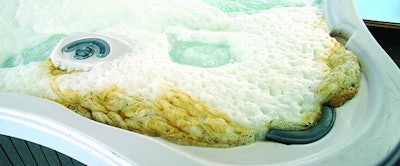
It’s a costly but necessary process — costly due to the expense of sewering the old water and buying new, heating it to a user-friendly temperature and filling it with sanitizer and (in some cases) appropriate supplements. And then there is the cost of labor.
It’s necessary because spa water contains more than just water. It’s a high-performance solvent for a diverse set of compounds — some of these enter the spa in the sourcewater, others are added intentionally in water care products and still others unintentionally when the human body slides below the surface and begins to release dead skin, sweat and other greasy substances into the surrounding medium.
Over time the soup becomes imperceptibly thicker. This occurs partly due to evaporation as individual H2O molecules become airborne, leaving impurities behind in an ever more concentrated solution. But the primary cause is that over time, more and more bathers leave behind their wastes, and more chemicals are added to maintain pH, ORP, etc., and these simply build up.
At some point, water quality becomes difficult to manage. Its chemistry becomes unresponsive — sort of like driving a vegetable truck. Specific problems crop up, letting you know it’s time to drain.
Efficiency asks whether this chore can be put off; it demands we get the maximum use from each fill. Science and experience replies with a somewhat vague “perhaps.”
“It’s possible to some degree,” says Karen Rigsby, technical services leader at BioLab, “but I’ll be honest with you, there are people out there saying that you can get as much as a year from your spa before draining it, and I consider that to be an unreasonable period of time. A lot of people think of spas as little swimming pools, but you really need to think of spas as big bathtubs. And you wouldn’t extend that water beyond its useful life.
“But sure, there are things you can do to extend the life of your water.”
Oxidize For Life
Start with common sense measures such as a regular schedule of oxidizing, says John Bokor, regional sales manager, Haviland Enterprises. Bokor has many years’ experience in both the chemical manufacturing side and the retail and service side. “That can extend the life of spa water tremendously. Breaking down the organics before they have a chance to build up on us. What’s happening is you’re breaking down that material and keeping it from accumulating. As it builds, it snowballs, so it consumes more and more product.
For instance, Bokor says, a normal oxidizing treatment might be 2 ounces for 500 gallons. But with a large buildup of waste, 4 to 6 ounces of shock may be required to achieve the same goal.
“Don’t forget the more product you add, the more you raise the TDS and the sooner you’re going to have to drain the tub,” he says, “so keeping up with that demand is critical, because once it gets out of hand, it takes too much of any chemical to fix things. You’re better off just draining it.”
A useful tool in keeping on top of waste accumulation and getting the most out of a tub of water is an application of enzymes — many spa chemical manufacturers offer this type of product. This supplement attacks bather coatings, the slippery substances that wash off the skin in a blast of hot turbulent water — everything from lotion to makeup to the naturally occurring oil of the epidermis.
Enzymes break down these greasy materials, reducing sanitizer demand and the need to shock.
Another helpful spa water ingredient, according to Bokor, is sodium tetraborate pentahydrate, better known as borate. “It eliminates the need for a lot of pH and alkalinity adjustment — it acts as another buffer for the water. Well we know that total alkalinity helps to buffer pH or help keep it in line. Borates do the same thing.
“Once you get the total alkalinity adjusted, then we add the borates to the water, and it tends to lock it in. You don’t get the pH bounce or movement, and that stable pH allows us to use less pH reducer in the spa. And the less product you add, the longer your spa water is going to last.”
Watch TDS Climb, Then Pounce
Of course, these measures will only delay the inevitable. There is no regimen that can extend the life of spa water indefinitely. So the question becomes, precisely when is the right time to dump and begin afresh?
There are so many different spa use scenarios that trying to come up with anything like a standard lifetime for spa water is impossible. For instance, a spa service professional operating in a place like Aspen, Colorado, will see bather load vary dramatically depending on the time of year. In the high season, a spa might need to be dumped every few weeks or even more often than that, while in the off-season draining might be required only once every 6 months.
Even more important than frequency of usage is the condition or character of usage. A fastidious and cost-conscious homeowner will add a much lighter bather load to the water than a group of gals using a tub in a vacation rental as part of a bachelorette party weekend.
It’s not a cut and dried decision, Rigsby says. It’s best to consider the commonly used formula (see sidebar) as a guide and measure the TDS level on a regular basis, watching it climb, providing you an idea as to the state of the water.
Even then, she says, “there isn’t an exact TDS measurement where if you go 1 ppm beyond it, then you absolutely have to drain. That TDS reading is really more of a guide. When it gets high, it’s time to keep an eye on the water:
1) Is it starting to look cloudy?2) Is it starting to foam?3) Are you starting to see more buildup along the waterline?
“If so, it’s time to drain.”
“For the most part,” Rigsby adds, “it’s just a matter of good basic maintenance principles, but in summary I would say that there are some things you can do besides taking good care of the water, having a good shocking routine and keeping the filter well maintained — there are enzymes you can buy that will help keep the waterline clean and just getting in there and physically wiping down that waterline is important, as well.
“Doing all that will help you push that spa water a little bit longer, but there will come a time when it’s not reasonable to think you can continue to avoid draining.
“You will be dealing with problems. And this is not a swimming pool — the cost and difficulty is not in that realm at all — it’s a big bathtub, and it’s sometimes cheapest and easiest to just dump it and start all over.”
Icy Challenge
Many spa owners like the feeling of looking up at the stars while relaxing and letting the bubbling water do its magic. In the frozen north, with mid-winter temperatures plunging below zero, the spa drain procedure gets a little complicated, Bokor notes.
“Up here in Michigan, with our winters, you can’t drain an outdoor spa in February because things are going to freeze up on you. So you try and time it. You hold off until the last chance to drain before things get too cold, and then you try to hold out until March or April.”
Hot Tub Calculus
Calculating Spa Water Life
Generally, spas should be drained when the measured TDS reaches 1,500 ppm above the start-up level, typically 2,000 to 3,000 ppm. Many spa professionals use the following handy formula for use as a guide.First, divide your total spa gallons by 3. Divide this result by your Bather Load, which is the average number of bathers per day. This gives you the number of days between drainings.
(Gallons/3) / Bather Load = drain period
Or, for those of you who prefer the metric system, take the spa volume in liters and divide by 10 times the Bather Load.Liters/ (10 x Bather Load) = drain period
Example 1 (US customary units): 480 gallon residential spa with Bather Load of 4 persons per day:(480 gallon spa/3)/4 persons per day = 40 days
Example 2 (US customary units): 1,500 gallon spa with Bather Load of 10 persons per day(1,500 gallon spa/3)/10 persons per day = 50 days
Comments or thoughts on this article? Please e-mail [email protected].












































